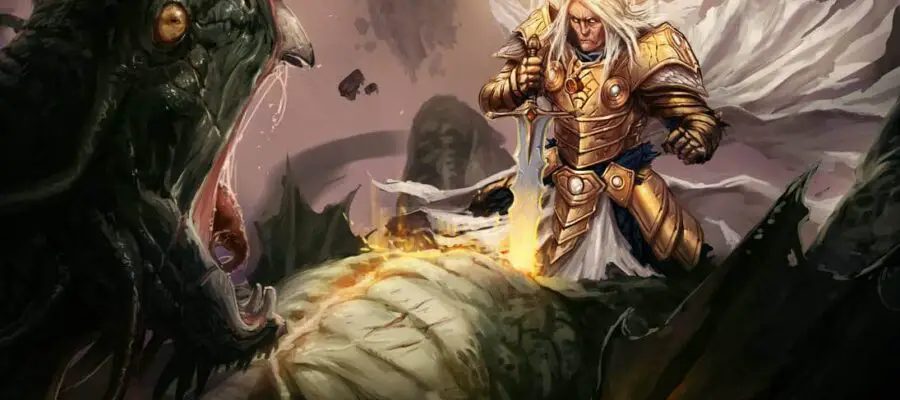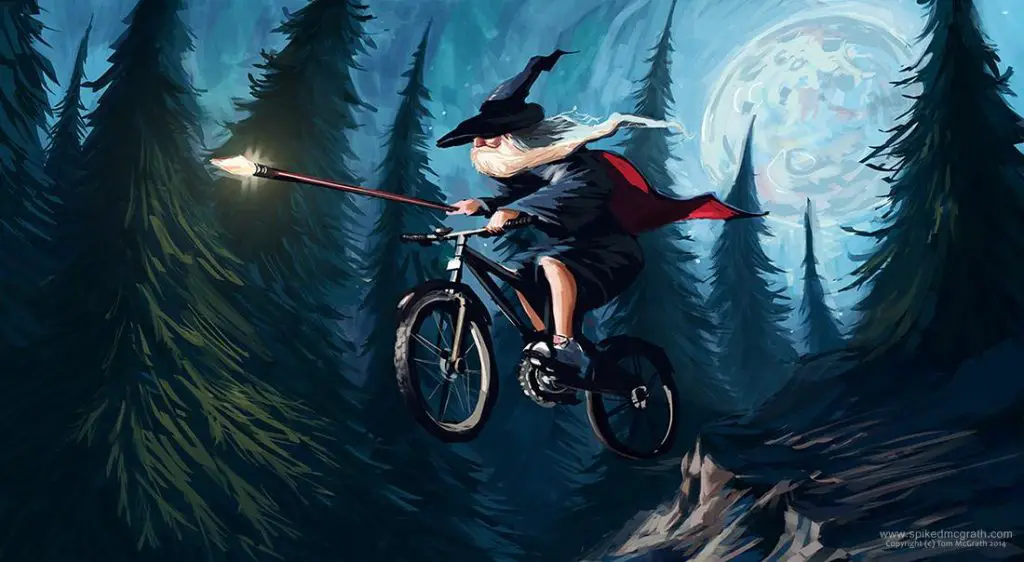Featured image for Aasimar Paladin Warlock Rogue is “Paizo Illustration” by Paizo, CC Attribution-Noncommercial-No Derivative Works 3.0 License
Disclaimer: This article contains affiliate links that add gold to our coffers.
Article Update: A question arose about the Hex Warrior’s ability to use a greatsword with Charisma since Hex Warrior doesn’t work with two-handed weapons; however, that concern is answered by reading the last few sentences of Hex Warrior that clarify that this limitation is overcome when Pact of the Blade is chosen at level three! We just wanted to clear that up upfront. Enjoy the read!
Combining Oathbreaker, Hexblade, and Swashbuckler as a Scourge Aasimar, you can discover a fruitful opportunity for intense backstory and character-developing role play in a power-build with breathtakingly stackable damage output.
Celestial blood runs through your veins. You’ve championed for your god your whole life, until you saw the light. Now, as an Oathbreaker, you feel an all-consuming desire to destroy what you discovered ‘evil’ really is, but on your own terms, and with the help of a power that has shown you truth. You battle within the loss of your guiding god, replaced by some mysterious entity from the Shadowfell, and your ambition to oppose true evil. You are left with a disoriented rationale.
In this build, you’ll have a sure-fire chance to hit first and hard, dealing an average of 198 damage in your first turn.
Here’s the Build Breakdown:
Paladin Oathbreaker: 11 levels
- Divine Smite 2d8 + 1d8/spell slot over level 1 (can use Warlock spell slots for this)
- Extra Attack
- Aura of Protection and Aura of Courage
- Improved Divine Smite (extra 1d8 of damage with melee attack)
Oathbreaker Abilities (Dungeon Master’s Guide):
- Control Undead: Raise undead to attack on your turn. They will also deal an additional 5 damage with Aura of Hate (see below).
- Dreadful Aspect: Each creature of your choice within 30 feet of you must make a Wisdom saving throw or be frightened of you for 1 minute.
- Aura of Hate: You and any fiends and undead within 10 feet of you gain a bonus to melee weapon damage rolls equal to your Charisma modifier.
Warlock Hexblade: 5 levels
- Two 3rd level spell slots (can be used for Divine Smite)
- Learn cantrips, spells, and invocations
- Pact of the Blade
Hexblade Abilities (Xanathar’s Guide to Everything):
- Hexblade’s Curse: Once per short rest, curse someone as a bonus action within 30 feet of you for one minute. You gain a bonus to damage rolls against the cursed target equal to your proficiency bonus. Crit on a 19 or a 20 against your cursed target. If the cursed target dies, you regain hit points equal to your Warlock level + your Charisma modifier.
- Hex Warrior: Touch one weapon and use your Charisma modifier for attack and damage rolls (!!!). This is HUGE for a Paladin build.
Rogue Swashbuckler: 4 levels
- 2d6 Sneak Attack (if using finesse weapon, which we are not in this build)
- Expertise
- Cunning action
Swashbuckler Abilities (Sword Coast Adventurer’s Guide):
- Fancy Footwork: During your turn, if you make a melee attack against a creature, that creature can’t make opportunity attacks against you for the rest of your turn.
- Rakish Audacity: Add your Charisma modifier to your initiative rolls. In addition, you don’t need advantage on your attack roll to use your Sneak Attack if no creature other than your target is within 5 feet of you.
Why Rogue?
While it’s true that Sneak Attack won’t profit this build much (if at all) without a finesse weapon, we included the four levels of Rogue for utility more than damage output:
By adding Charisma to initiative, our character can hit first. This is imperative with such a huge damage output—if you get to the boss first, and take him down, you’ve just saved your party a lot of grief (sometimes to the DM’s dismay). Sometimes, if enemies go first, you get bogged down and stuck fighting minions.
At the end of this article, you can find alternative options for this build.
Race: Scourge Aasimar (Volo’s Guide to Monsters)
- Increase Charisma by 2
- Increase Constitution by 1
- Darkvision
- Resistance to necrotic damage and radiant damage
- Healing Hands: Give a creature hit points equal to your level once per long rest.
- Light cantrip (use Charisma)
- Speak/read/write Common and Celestial
- Radiant Consumption: Once per long rest, use action to activate. For one minute or until you end it as a bonus action, shed bright light in a 10-foot radius and dim light 10 more feet. At the end of each of your turns, you and each creature within 10 feet of you take radiant damage equal to half your level (rounded up). In addition, once on each of your turns, deal extra radiant damage equal to your level to one target you have damaged with an attack or spell this round.
Feats:
Tough: Hitpoint maximum increases by 2 per level. You’ll need this boost to hit points because of your Radiant Consumption.
Lucky: Reroll any D20 using one of your three luck points each long rest. With all the chances to crit, you want to hit hard and accurately on one turn.
Great Weapon Master: On your turn, when you score a critical hit with a melee weapon or reduce a creature to 0 hit points, you can make one melee weapon attack as a bonus action. Also, before you make a melee attack with a heavy weapon with which you are proficient, you can choose to take a -5 penalty to the attack roll. If the attack hits, deal +10 damage. You use Charisma and proficiency bonus to hit, so you’ll already have a bonus of 11 to hit. This is worth it.
Fighting Style:
Great Weapon Fighting Style: When you roll a 1 or 2 on a damage die for an attack you make with a 2-handed or versatile melee weapon, you can reroll the die (must use the new roll).
With the chance to crit on 19 or 20, you’ll be rolling twice as many dice one-tenth of the time. You don’t want to waste those extra rolls on a 1 or a 2.
Maximum Damage Output:
At level 20, assuming your Charisma is maxed out, and you’ve used previous actions to set up Hexblade Curse and Radiant Consumption, here’s the maximum damage output:
Attack 1:
- Greatsword: 2d6 + 5
- Radiant Consumption: 30
- Divine Smite with 3rd Level Spell Slot: 4d8 radiant
- Improved Divine Smite: 1d8 radiant
- Aura of Hate: +5
- Hexblade Curse: +6
- Great Weapon Master Bonus: 10
Attack 2:
- Greatsword: 2d6 + 5
- Divine Smite with 3rd Level Spell Slot: 4d8 radiant
- Improved Divine Smite: 1d8 radiant
- Aura of Hate: +5
- Hexblade Curse: +6
- Great Weapon Master Bonus: 10
Great Weapon Master Bonus Action (Additional Attack if Critical Hit or Reduce Creature to 0 HP)
- Greatsword 2d6 + 5
- Divine Smite with 2nd Level Spell Slot: 3d8 radiant
- Improved Divine Smite: 1d8 radiant
- Aura of Hate: +5
- Hexblade Curse: +6
- Great Weapon Master Bonus: 10
Total Damage: 6d6 + 13d8 + 118
Average: 21 + 59 + 118 = 198
Remember:
- Reroll 1’s and 2’s of damage dice (not accounted for in the average count above).
- Crits occur on 19’s and 20’s (not accounted for above except with Great Weapon Master bonus attack).
- You have three lucky points per long rest.
- Regain 10 hit points when you kill the creature you cursed.
- You can raise undead minions to attack by your side. They benefit from your Aura of Hate, +5 damage.
Things to Note:
Invocations:
Focus on invocations that give utility out of battle or cover ranged attacks.
- Eldritch Smite is just like Divine Smite in that it expends spell slots for 1d8 +1d8 damage/spell slot, but if it hits, knocks a creature prone, which gives you advantage on melee attacks.
- Agonizing Blast will add an additional 5 damage to each Eldritch Blast (which is a cantrip), and at level 17, you get a total of four blasts! This will cover ranged attacks pretty well.
Sneak Attack Workaround:
Also, note that you won’t gain Sneak Attack damage with a Greatsword. Discuss with your DM options for a homebrew weapon with finesse and versatile or 2-handed properties, like a Katana. For a list of commonly used swords throughout history to inspire your weapon build, see our article A Guide to Common Swords.
Spells to Choose:
For both Paladin and Warlock spells, focus on utility or buffs, such as Aura of Vitality, which heals you passively in battle.
Alternative Build
If you want to focus more on damage output over the utility Swashbuckler provides, here is an alternative option to consider:
Take an Additional 4 Levels in Warlock
With 9 total levels in Warlock, you’ll gain:
- Accursed Specter: Once per long rest, temporarily raise a corpse you’ve slain as a specter with hit points equal to half your Warlock level. This creature will obey your commands and has an attack bonus modifier equal to your Charisma modifier. The specter’s stats are in the Monster Manual and count as undead, meaning you can add your Aura of Hate, giving them an additional 5 points of damage. This creature remains until the end of your next long rest.
- Warlock spell slots at level 5. You will still only have two of these, but you can upgrade your Divine Smite to 5d8 with these spell slots (6d8 with Improved Divine Smite). This would increase your total damage to:
Total Damage: 6d6 + 17d8 + 118
Average: 21 + 77 + 118 = 216
Need help multiclassing? See our Ultimate How To Multiclass Guide.
Interested in other multiclassing combinations? See what works in this Multiclass Combinations Article.
See our other multiclass articles:
The Hexarcher: Ranger/Warlock/Fighter
Monkey Fist: Druid/Monk
Assassin of the Grave: Rogue/Cleric
Master Assassin: Rogue/Fighter
Arcane Assassin Archer: Rogue/Fighter
5e Analysis of the Ranger Paladin Multiclass
The Ultimate Rogue/Fighter Multiclass Guide





So what happens after the first encounter? You die because you burned all your slots on the first enemy trying to powerfully kill it. That means anything after that will wreck your no-slot paladin who can no longer smite.
Hey Dean! Thanks for commenting. Would you generally believe this about a straight Paladin build? By multiclassing with a Warlock, a Paladin can use all Warlock and Paladin spell slots to smite, so we’re looking at 10 smites from Paladin and 2 from Warlock for a total of 12 smites. In the first round, we’re using 3 of those, so you’re good for about 4 more rounds of smiting using the same methods. Thanks for reading!
Hi Dean!
In addition to Opal’s point that there are plenty of spell slots remaining, there is also an indirect benefit of helping allies conserve their own resources when you deal burst damage like this. This character is part of a team that may conserve resources due to this type of character making short work of powerful foes. And it’s worth mentioning that this damage burst wouldn’t be necessary against weaker foes/minions, so it would be used selectively.
Really loved the idea and gave it a go for my first character, just got the first level in Warlock after going five in Paladin. Can’t wait for the next two for those sweet charisma modifiers!
I would like to note something though. You’ll neither get 25 HP after you kill your cursed target, nor a four-beam Eldritch Blast. Those are dependent on the Warlock level, not the player level.
Hi AHappyCustomer, thank you for the input!
I’m happy to report that cantrips actually scale based on character level, not class level. So this character will indeed have a four-beam Eldritch Blast. This is evident in each damage-based cantrips spell description when it mentions level but not class level.
You’re correct about the 25 HP. With only five levels in Warlock, and the healing based on Warlock level and Charisma, it’s expected that slaying the cursed target will allow you to regain 10 HP (not 25 HP). I’ve fixed this in the article, so thank you for pointing it out!
Good luck with your character!
Oh that’s great news, looking forward to those two stream-blasts in our next session! : ) I misread that then.
Another thing though, in the alternative build you state that using level 5 slots for smite will result in 6d8, in smites descprition it is stated that the maximum is 5d8 on level 4 slots, becoming 6d8 when fighting undead.
Thank you so much for the reply and for your work here. I know a lot of peope do thoroughly enjoy it.
Cheers!
Hi AHappyCustomer, while you are correct on the maximum spell slot that can be used for Divine Smite capping out at 5d8 on non-undead creatures, the alternative build is accounting for the Paladin’s Improved Divine Smite feature to grant each attack with an additional 1d8 damage. This is why the alternative build quotes 6d8 damage instead of 5d8. I made a text change to the paragraph in order to make it clear that Improved Divine Smite is being factored in (but not undead targeting). 🙂
Once again I stand corrected! : ) So great to see you take your time and answer. I just picked up D&D in March this year and I enjoy every minute of it.
One question, if I may. I leveled my Paladin to level five before I took one level in warlock. At that point I had four level one spellslot and two level two spellslots from beeing a level five Paladin. If I understand the multiclassing table correctly, through gaining levels in another spellcasting class my spellcadting level is now my Paladin level divided by two which is two which gives me three level one spellslots plus one level one slot from pact magic.
So now I went down to four level one spellslots, is that correct?
It has been an interesting year to pick up D&D, haha! I’m always pleased to hear of new people picking up the hobby. And I’m always happy to help with questions, and I appreciate readers making sure our articles are clear and correct.
To your question, multiclassing rules treats Warlocks differently. If you read page 164 of the PHB, Pact Magic (Warlock magic) is treated separately from other spell slots when considering multiclassed spell slot inventory. This actually make it easy for you. You’ll simply add up the spell slots you have as a Paladin with the spell slots you receive from Warlock Pact Magic. For example, with five levels of Paladin and one level of Warlock, you’ll have four level-one spell slots and two level-two spell slots from Paladin, and you’ll also have one level-one spell slot from Warlock. This gives you a total of five level-one spell slots and two level-two spell slots. This point is further evidenced by the Warlock being absent from the multiclassing rules that mention adding up levels and doing division to determine spell slots. The Pact Magic rules for multiclassing also clarify that you can use Warlock spell slots to cast spells from your other classes, and vice versa. To further clarify, the adding up of different spellcasting classes to get your total spellcaster level is only done when you have multiple classes giving you the “Spellcasting” feature. The Warlock class does not have the “Spellcasting” feature, it has Pact Magic, so that’s why we do things differently for Warlocks.
Thank you for the clarification, great news! I really need those smiteslots, feels kinda naked without them. :>
The last part really made it clear for me. I got hung up on the “any other spellcasting class” because I thought “ofc warlocks are casting spells!”, so breaking it down to “pact magic is not the spellcasting feature” made that easy.
I hope I may annoy you some more in the future as my ohhh so edgy Hexbreaker Aasimar advances and I may encounter new situations I don’t fully understand.
PS: since we are playing Tiamat, it seems that I will get Hazirawn. I am a little sad that I spoilerd that for myself on accident, but the rolls could be interesting.
Comment all you like! It’s not pestering at all. 🙂
Awesome build, totally gonna use this as a base myself. Hex Warrior doesn’t work with two-handed, so a greatsword wouldn’t allow you to use the CHA for damage. So you would either have to lose that bonus and retain the second effect of great weapon master, or you change the weapon and lose that second effect.
Wow, I’m a bit ashamed that we overlooked this. You are absolutely correct, as there are no heavy weapons that lack the two-handed property. We’ll have to rework this article. Thank you for keeping our content accurate!
Using a great sword can still benefit from using your charisma modifier for attack and damage rolls as long as you take the Pact of the Blade feature. In Xanathars Guide to Everything page 55-56. It states; This benefit (using charisma for attack and damage rolls) lasts until you finish a long rest. If you later gain the Pact of the Blade feature, this benefit extends to every pact weapon you conjure with that feature, no matter the weapon’s type”.
You guys had it right!
Oh wow, you’re right! Pact of the Blade is the part we forgot today. Thank you WereHunter7 for bringing that up (especially because it’s easy to miss on the second page of the Hex Warrior description, haha). We haven’t looked at the Hex Warrior feature in a while, so we questioned whether we had made a mistake. Thank you for pointing out that we had it right before! We should’ve trusted our younger selves 😛
What would you recommend the build order be?
The build order may depend on your backstory and character development/plot. However, there are some things to consider in terms of what you value most in your campaign: damage output, utility, or maneuverability.
Starting as a Rogue, you’ll have 4 skill proficiencies and some slight armor proficiencies. You will gain medium armor, shield, and martial weapon proficiencies when you multiclass into a Paladin. However, your saving throws will be Intelligence and Dexterity, which may not serve you well. You can read our table of proficiencies gained here: https://www.flutesloot.com/how-to-multiclass-in-5e/#proficiencies
If you plan on utilizing spellcasting (not just using spellslots to smite), start as a Paladin to gain the Wisdom and Charisma saving throws. Multiclassing into a Rogue will give you an extra skill and thieves’ tools.
Honestly, I might start with at least 5 levels of Paladin, 3 levels Warlock, 4 levels Rogue, 2 levels Warlock, then finish off with Paladin. This will give you your Extra Attack as Paladin, then get your Pact of the Blade abilities and extra spell slots for smiting quickly, then maneuverability as a Rogue. Feel out how your campaign is progressing and what sort of skills you need to gain quicker than others.
Paladin and Warlock = damage output and utility (depending on the level you get to)
Rogue = maneuverability and utility
Hope this helps!
I have something similar, but instead of Oathbreaker, I went Oath of Vengeance. Vow of Enmity gives you advantage on that one creature you want to kill, increasing your chances of a crit, especially alongside the 19-20 crit from the hexblades curse, lots of eldritch and divine smite damage. Oath of Vengeance is also nice for maneuverability since you get misty step on your spell list
Hi Hunter!
Oath of Vengeance is such a powerhouse! I can’t blame you for going that route, certainly.
This is a really fun and thematic build! There are a couple of other options I’d suggest to make them even more of a hit first hit hard beatstick:
1) Take the alert feat instead of/alongside the four levels of rogue. This will give you +5 to initiative as well as immunity to surprise rounds (crucial given it takes a full turn to set up your Aasimar ability and hexblade’s curse). You can also pick up the sentinel shield as a non-attunement magic item for advantage on initiative (you don’t actually need to use the shield in combat to get this). Those four levels of rogue can then be put into upping your warlock spellslots. Versatility is nice, but given you’ll probably already be the party face with CHA 20 as well as the biggest combat beatstick, leaving some spotlight for other party members increases the chances of your campaign actually reaching level 20.
2) Rather than the rogue, a good option is a two level dip in fighter. This gives you an extra fighting style (defence for the improved AC would be my pick), second wind but most importantly action surge.
3) For a slightly less brooding version of this character (or if your DM is on board, perhaps a ‘redeemed’ version post character story arc), I’d heartily recommend the combination of oath of vengeance paladin with defender aasmiar. This not only gets you vow of emnity as mentioned above, but more usefully gives you haste as a domain spell and radiant soul, which gives you the additional damage of scourge aasimar but as the much less commonly resisted radiant type, not to mention a 30ft flying speed to catch those hard to reach enemies. Of course, haste and hexblade’s curse plus radiant soul and vow of enmity is two turns to set up, but if you’re cunning you can work the latter two into your RP as the BBEG is finishing their monologue!
Action surge + haste GWM gives you six attacks, critting on 19. Yes you lose the aura of hate bonus but you’re gaining an extra +48 from the three additional attacks with Hexblade’s curse and GWM, and your allies can take advantage of your auras without sucking up that necrotic damage.